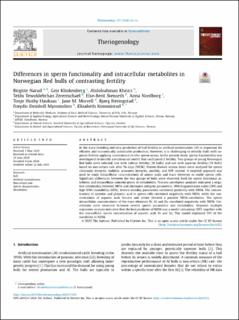| dc.description.abstract | In the dairy breeding industry, prediction of bull fertility in artificial insemination (AI) is important for efficient and economically sustainable production. However, it is challenging to identify bulls with superior fertility applying conventional in vitro sperm assays. In the present study, sperm functionality was investigated to identify a multivariate model that could predict fertility. Two groups of young Norwegian Red bulls were selected, one with inferior fertility (18 bulls) and one with superior fertility (19 bulls) based on non-return rate after 56 days (NR56). Frozen-thawed semen doses were analysed for sperm chromatin integrity, viability, acrosome integrity, motility, and ATP content. A targeted approach was used to study intracellular concentrations of amino acids and trace elements in viable sperm cells. Significant differences between the two groups of bulls were observed, both for sperm functional attributes and intracellular concentrations of metabolites. Pearson correlation analyses indicated a negative relationship between NR56 and chromatin integrity parameters, DNA fragmentation index (DFI) and high DNA stainability (HDS). Several motility parameters correlated positively with NR56. The concentrations of cysteine and glutamic acid in sperm cells correlated negatively with NR56, while the concentrations of aspartic acid, leucine and serine showed a positive NR56-correlation. The sperm intracellular concentrations of the trace elements Fe, Al and Zn, correlated negatively with NR56. Correlations were observed between several sperm parameters and metabolites. Stepwise multiple regression analysis indicated that the best predictor of NR56 was a model containing %DFI, together with the intracellular sperm concentration of aspartic acid, Fe and Zn. This model explained 59% of the variability in NR56. | en_US |
